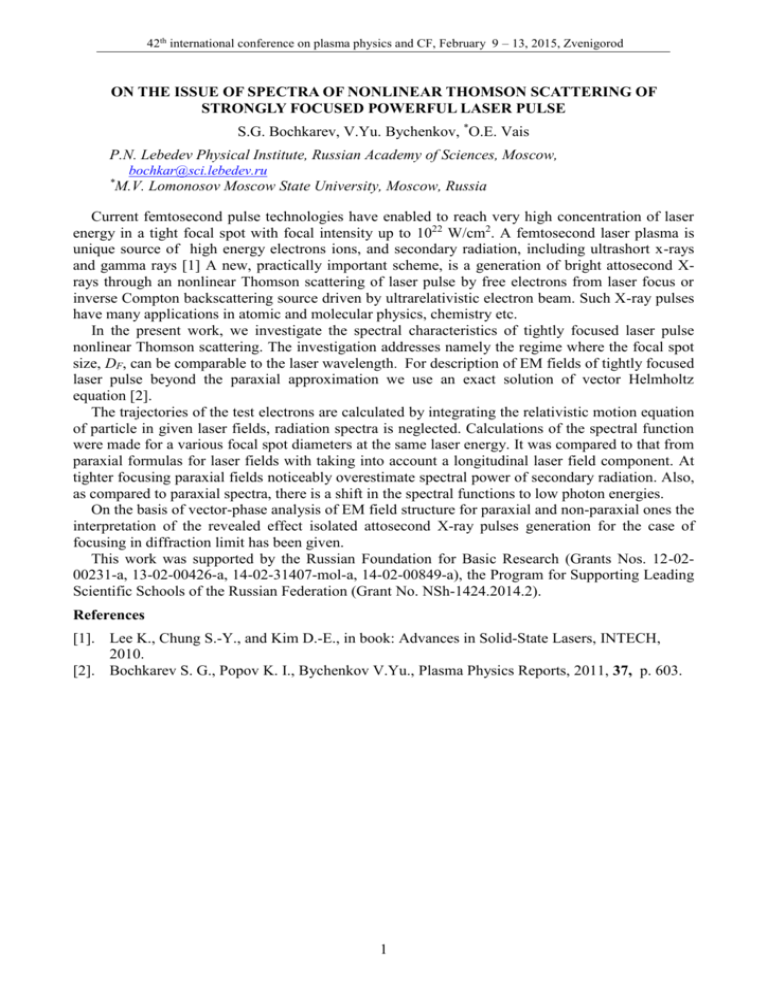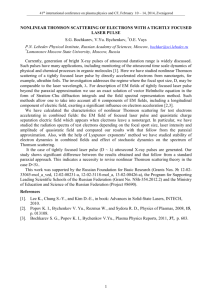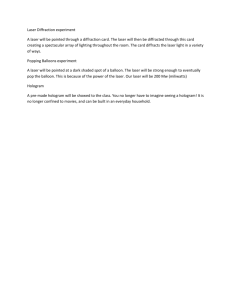on the issue of spectra of nonlinear thomson scattering of strongly
advertisement

42th international conference on plasma physics and CF, February 9 – 13, 2015, Zvenigorod ON THE ISSUE OF SPECTRA OF NONLINEAR THOMSON SCATTERING OF STRONGLY FOCUSED POWERFUL LASER PULSE S.G. Bochkarev, V.Yu. Bychenkov, *O.E. Vais P.N. Lebedev Physical Institute, Russian Academy of Sciences, Moscow, bochkar@sci.lebedev.ru * M.V. Lomonosov Moscow State University, Moscow, Russia Current femtosecond pulse technologies have enabled to reach very high concentration of laser energy in a tight focal spot with focal intensity up to 1022 W/cm2. A femtosecond laser plasma is unique source of high energy electrons ions, and secondary radiation, including ultrashort x-rays and gamma rays [1] A new, practically important scheme, is a generation of bright attosecond Xrays through an nonlinear Thomson scattering of laser pulse by free electrons from laser focus or inverse Compton backscattering source driven by ultrarelativistic electron beam. Such X-ray pulses have many applications in atomic and molecular physics, chemistry etc. In the present work, we investigate the spectral characteristics of tightly focused laser pulse nonlinear Thomson scattering. The investigation addresses namely the regime where the focal spot size, DF, can be comparable to the laser wavelength. For description of EM fields of tightly focused laser pulse beyond the paraxial approximation we use an exact solution of vector Helmholtz equation [2]. The trajectories of the test electrons are calculated by integrating the relativistic motion equation of particle in given laser fields, radiation spectra is neglected. Calculations of the spectral function were made for a various focal spot diameters at the same laser energy. It was compared to that from paraxial formulas for laser fields with taking into account a longitudinal laser field component. At tighter focusing paraxial fields noticeably overestimate spectral power of secondary radiation. Also, as compared to paraxial spectra, there is a shift in the spectral functions to low photon energies. On the basis of vector-phase analysis of EM field structure for paraxial and non-paraxial ones the interpretation of the revealed effect isolated attosecond X-ray pulses generation for the case of focusing in diffraction limit has been given. This work was supported by the Russian Foundation for Basic Research (Grants Nos. 12-0200231-a, 13-02-00426-a, 14-02-31407-mol-a, 14-02-00849-a), the Program for Supporting Leading Scientific Schools of the Russian Federation (Grant No. NSh-1424.2014.2). References [1]. Lee K., Chung S.-Y., and Kim D.-E., in book: Advances in Solid-State Lasers, INTECH, 2010. [2]. Bochkarev S. G., Popov K. I., Bychenkov V.Yu., Plasma Physics Reports, 2011, 37, p. 603. 1







